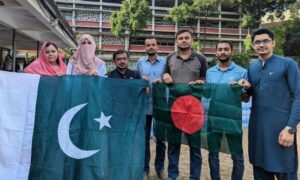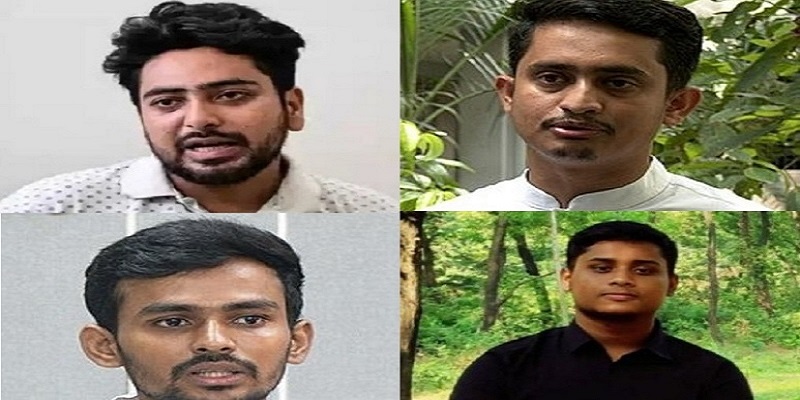Batches of Bangladeshi students handpicked as “coordinators”, visited Pakistan, Dubai and Qatar where they met a host of intelligence and security officials, including some from the US, over a period of more than one year, the Indian national security network has learnt after piecing together assorted strands of information within and outside Bangladesh.
Acting in coordination, albeit after the massive students’ protest and the accompanying deadly violence that claimed around 1,000 lives, several Indian intelligence agencies and security organisations traditionally focused on Bangladesh have been able to “work out” the means and ways employed and deployed by the US security establishment and the State Department.
The “conspiracy” to enlist a “compact number” of students, aimed at dislodging the Sheikh Hasina regime began in April 2023 when one student (whose identity is being concealed for security reasons) visited Pakistan and met with an Inter-Services Intelligence (ISI) officer.
One of these students is Mohammad Mahfuz Alam who was appointed as a special assistant to interim government Chief Adviser Mohammad Yunus on August 28. Besides Alam, a host of Bangladeshi students who led the movement to unseat Hasina underwent madrassah education before they enrolled themselves in different colleges and universities across the country and in Dhaka particularly.
In the subsequent months, this was followed by the visit to that country by three other students. Each of the students left Dhaka’s Shah Jalal International Airport on separate dates so that no suspicion would be aroused among Bangladeshi intelligence agencies.
A retired ISI lieutenant general was assigned the task of liaising with the Bangladeshi students who returned to Dhaka on separate dates. Both Bangladeshi security agencies, including the Directorate General of Forces Intelligence (DGFI) and Special Branch, and Indian intelligence operatives had little clue about the students’ visits to Pakistan and the ISI officers they met with between April and September 2023.
“This retired ISI lieutenant general, working under an assumed name, visited Bangladesh several times over a period of one year,” an Indian official said.
While Indian security professionals continue to amass and analyse a large volume of information emanating from “different sources (including scanned copies of the students’ passports) within and outside Bangladesh”, they have found a critical link between the students and the Qatari government that was used by the US security officials to funnel large volumes of money to different bank accounts in Bangladesh and abroad.
What is the startling is that the same Pakistani retired ISI lieutenant general met another group of Bangladeshi students in a Doha hotel between April and September 2023 when the US State Department, particularly the then Ambassador Peter Haas, started taking the first resolute steps to applying diplomatic pressure on the then Sheikh Hasina regime to hold “free, fair and violence-free elections”.
Indian security officials suspect that “some US citizens” – their real identities are in the process of being ascertained – checked into the same Doha hotel and likely “interacted” with the students. “We are closely examining the role that least three of them played during these meetings and later following their return to the US,” one security official said.
It is also suspected that a senior Bangladeshi social development sector professional, who is now a key figure in the interim government, met the ISI lieutenant general in Doha around the same the students did.
In September 2023 – by which time the process to talent spot and select the main student coordinators had been completed – a small team of three students met their Pakistani handlers in a Dubai hotel on at least “six to seven” occasions.
Indian security specialists said that the DGFI “had some prior information related to the students’ visit to Pakistan, Dubai and Doha” but they “simply could not fathom or analyse the scale of the operation” before Hasina’s ouster and eventual flight to India. “Hasina had been briefed about the US operation involving the students and university professors in May 2024, but she couldn’t grasp or believe the extent and depth of the conspiracy,” an official said.
While most Bangladeshi and Indian officials focused on Bangladesh were busy with preparations involving the January 7 elections, the Russian intelligence network was “alive” and keeping tabs on the “unusual” meetings between American and Pakistani intelligence operatives and the students.
This, Indian and Bangladeshi sources now say, was the November 2023 message that was sought to be delivered by Russian Foreign Ministry spokesperson Maria Zakharova who, during a weekly briefing in Moscow the same month had claimed that the Haas met and discussed plans to organise a mass anti-Awami League protests in Bangladesh.
For the record, Northeast News had earlier reported on a Dhaka-based US diplomat’s series of clandestine meetings with Dhaka University Law Department Professor Asif Nazrul before Bangladesh’s January 7 ‘election’.
On January 8, a day after the so-called parliamentary elections of January 7, Zakharova had said that there were “external attempts to influence” the elections, in a not-so-veiled attempt to name the US.
The Indian national security bureaucracy now believes that it has sufficient information to establish the direct role of the Hizbut Tehrir which was banned in Bangladesh in 2009. Indeed, Indian security officials suspect that the roots of the students’ anti-discrimination movement are in a lesson called ‘Gurubar Adda’ which was started by an on-campus group of Dhaka University students in 2021.
Mahfuz Alam, now on Yunus’ staff, led this secretive group which had members drawn from not only the Hizbut Tehrir but also the Islami Chhatra Shibir, the students’ wing of the Jamaat-e-Islami.
In 2023, around the time some of the students visited Pakistan, several members owing allegiance to the Chhatra Odhikar Sangrakkhan Parishad (Students Rights Protection Council) resigned from the outfit to launch a new political platform called Ganatantri Chhatra Shakti, which also included members of Gurubar Adda’s Pathachakra.
Bangladesh police sources Northeast News spoke with for this story indicated that Mohammad Harun-ur Rashid, the former Detective Branch chief of the Dhaka Metropolitan Police (DMP) had got wind of the students’ conspiracy “from his own sources”.
ALSO READ: A ‘new’ Bangladesh: Where is the roadmap for taking a deeply divided country out of the woods?
Before disappearing from public view, Rashid had called in the top six leaders of the students’ movement, including Sarjis Alam (who originally belonged to the Chhatra League), Nahid Islam, Asif Mahmud, and Hasnat Abdullah among others and questioned them on their Pakistani and US links.
It was for this reason that Rashid was reportedly given shelter by the Dhaka-based embassy of a Western country where he was said to have been debriefed on the information that he had “extracted” from the six students.















